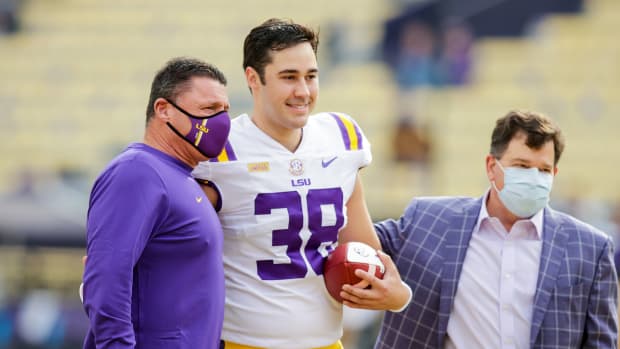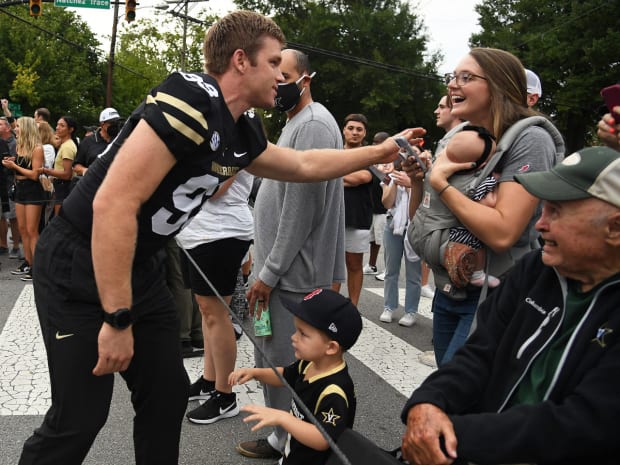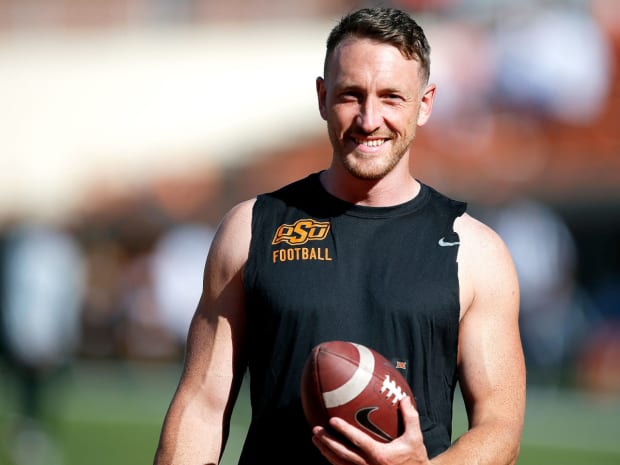When Zach Von Rosenberg was selected by the Pittsburgh Pirates out of high school in the sixth round of the 2009 MLB draft, his childhood dreams finally came true. He spent one season in rookie ball, four in Low A and one in High A—all in the Pirates’ system—but after six years in the minors, he began to feel like there was an expiration date on those dreams.
“I had been battling injuries, and it just didn’t pan out,” Von Rosenberg says. “A lot of guys battle injuries, and they can fight through it. I just wasn't one of those people. I just wasn’t good enough to play major league. It is what it is. The dream came to an end.”
A torn hamstring, nerve issues in his hand and wrist, recurring shoulder problems and a condition where he lost blood flow to his lower arm all resulted in the end of his baseball career. But after playing sports for 20 years, Von Rosenberg couldn’t walk away that easily.
“I talked to my mom, and I was like, ‘I don't know what I can do now. I’m still able-bodied, and I know I’m physically fit enough to play another sport. I haven’t been to college, and I want to walk on the football team,’” he says. “She was like, ‘Zach, you don’t know a life without sports, so I don’t see why you wouldn’t continue now?’”
While many ex-athletes seek out careers in coaching, sports broadcasting or even acting, Von Rosenberg hit the weight room and began training to walk on to LSU’s football roster at the age of 26. He became a four-year starting punter, two-time second-team All-SEC selection and a national champion in 2019. On top of it all, he was one of the oldest players in college football, playing his senior season at the age of 30.
Von Rosenberg isn’t the only college football player to use his eligibility later in life. Since 2004, at least 14 players across the NCAA have played above the age of 30—at least nine at the Division I level and seven in Power 5 programs. Some of them just barely crossed that 30-year mark—others more than doubled it.
Some chose to play to prove a point to others; some did it to prove something to themselves; some did it to make up for something lost; others did it to pay it forward. While they all have different stories and circumstances, each player defied the odds and accomplished a feat that most wouldn’t dare attempt.

Stephen Lew/USA TODAY Sports
Joe Thomas Sr. is believed to be the oldest D-I football player ever. He played running back at South Carolina State in 2016 at the age of 55. Most 55-year-olds are counting down the days until retirement, but Thomas had different plans and knew he owed it to himself to try to achieve a goal he set almost 40 years before.
“When I was a kid, I had low self-esteem,” he says. “I could barely hear. I have a bad speech impediment. I got teased about the way I pronounced words, so that was a reason I didn’t want to go to college at a young age. I got offer letters coming out of high school, but I didn’t take advantage of them because of what I went through as a kid.”
As he grew older, he grew out of his speech impediment. Through speech therapy, he became more confident and started to believe that college could be in the cards. Then, he began receiving signs he felt he couldn’t ignore.
“I had dreams for 10 years or better about playing football again,” he says. “I felt like God was talking to me.”
Whether it was divine intervention, newfound confidence or a combination of both, Thomas decided to walk on to the team at South Carolina State, making history and overcoming his lifelong fear.
Mike Flynt also faced a lifetime battle that led him back to football.
In the 1969 and ’70 seasons, a then 21- and 22-year-old Flynt played linebacker for Sul Ross State in Alpine, Texas. He was the captain and leading tackler on a team that was picked to win the Lone Star Conference heading into the ’71 season.
Flynt had a history of fighting at the school, as he had gotten in about 10 fights in two years. During two-a-days before classes started his senior year, he got in another brawl—but this one lost him his spot on the team and in school altogether.
“Being the team captain, that was my football team,” he says. “Those guys would play for me. They loved me, and I loved them. … Then I get in a fistfight that ends up getting me kicked out of school and off the team, and they didn’t even have a winning season. I think they went 4-6-1. And that became the greatest regret in my life.”
After his time at Sul Ross, Flynt went into the fitness industry and became a strength and conditioning coach at Nebraska, Oregon and Texas A&M. He stayed in great shape over the years and eventually found his way back to Southern Texas for a college reunion in 2007. That weekend, he told his teammates that getting kicked out was the biggest regret of his life and that he thought he could still play at age 59. His teammates’ response: Well, why don’t you?
He took that to heart and started pursuing playing again. He met with Sul Ross’s coach at the time, Steve Wright, and pitched his case.
“I said, ‘If I could make this team as a linebacker and help a bunch of young men that I don’t even know, for me, it would make up for those guys that I let down all those years ago. I’d like to have a chance to try,’” Flynt says.
Wright gave him that chance, and he made the team as a linebacker, earning the opportunity to make up for what he lost 36 years before.
When players decide they want to play college football years after high school, the first barrier to entry is eligibility.
Tom Gore learned that early on in his journey. His daughter was touring colleges in 2017, and when they arrived at Methodist University in Fayetteville, N.C., he thought he would attempt to chase his dream, too. He went to the coach’s office to see whether he could walk on the football team.
“I was like, ‘Coach, can I play football here?’ and he goes, ‘Are you eligible?’ And I was like, ‘I don't even know what that means,’” Gore says.
The NCAA doesn’t have an age limit, but its strict eligibility rules make it difficult for people above a certain age to play. At the D-I level, the moment you enroll in an institution, your time clock starts ticking—whether you are playing a sport or not. The only exemptions are military and religious reasons, which can pause the clock. If you decide to play a sport at the amateur level outside of college before enrolling, your eligibility will also be impacted. However, for players who graduate high school, never play that sport in an organized environment again, never enter college and go straight into the workforce, their time clock hasn’t started.
J.R. Smith—a former NBA star who enrolled at North Carolina A&T and joined the golf team in 2021 at the age of 35—is a prime example of this rule. If Smith had participated in amateur golf before enrolling or had previously attended college instead of going straight from high school to the NBA, he wouldn’t have been able to play at his age.
The five-year time clock applies to only D-I. At the D-II and D-III levels, there is a semester clock, so players who drop out can return and play until they reach 10 total semesters. For this reason, the most extreme scenarios around age and eligibility often happen at the D-III level.
Tom Thompson may have jumped over more eligibility hurdles than anyone. The oldest player in NCAA history, he kicked for Austin College in 2009 at 61. Thompson had received his doctorate in strategic leadership from Regent University in ’02 but had never played college football and was eager to do so.
“My circumstances were so convoluted that I was able to demonstrate to the NCAA that I was able to continue [getting an education], so I ended up with a year,” he says.
He enrolled in an undergraduate program and took classes like psychology and history to start. However, Austin College had only one graduate program, which was teaching, so he had to pursue that track to continually show progress and be able to play.

Christopher Hanewinckel/USA TODAY Sports
Even after making the decision to enroll in college and overcoming the eligibility hurdles, many players faced additional challenges once making the team.
“I think a little ageism seeps in,” says Tim Frisby, a 39- and 40-year-old wide receiver at South Carolina in 2004 and ’05. “You're just not supposed to be able to do things that they saw you doing at that age.”
Both Frisby and Thomas say they faced the most opposition from their coaches.
“I had one coach who kept talking trash and wanted me to say it back to him,” Thomas says. “I guess he was trying to get me to quit. He didn’t want me on the team.”
While the coaches were tough on them, it was a different story in the locker room, Frisby remembers. He says his bond with his teammates is one that has stuck with him ever since.
“I was the music man in the locker room,” Frisby says. “I had a boombox at the time up on top of my locker. Obviously, my music was generations different from theirs, but they gravitated to it. … I’d listen to [Jimi] Hendrix or old-school hip-hop. They’d be listening to the current stuff. It was a dynamic where they’re learning something from me, and I’m learning something from them.”
Thompson, who was 40 years older than his next oldest teammate, echoes that sentiment.
“The age just melted away. I wasn’t an oddity to them,” he says. “They were very protective, much like you’d imagine they’d be watching their grandfather play football.”
His teammates even wanted him to have an authentic college experience, often inviting him to their fraternity parties, he remembers.
“I went to one, and I took my wife,” he says. “It was fun for them because I was sort of a celebrity on campus.”
Still, there are a lot of reasons why someone may be skeptical about having a 40-, 50- or 60-year-old player on their roster in any sport at any level, but the top concern for many is physical ability. College athletes are some of the fittest people in the world and maintaining that vigor as the body ages isn’t easy.
For the players in their 30s, like Von Rosenberg and recent Vanderbilt tight end Tommy Smith, they say the physical challenges were negligible. Many of the 50- and 60-year-old players even say on the field, they felt the same. But the real challenge came during recovery.
“After practice, the younger guys could shower and go right home,” Frisby says. “I’d go back to the physical trainers to be restretched and iced. You had to take more care of your body than you would have to at a younger age. You had to preempt that by staying in the best physical shape you could and doing the best recovery techniques you could.”
But out there on the field, the older players felt they and their teammates were one and the same.
“There were no mirrors out there for me to see wrinkles on my face,” Flynt says. “I was in great shape. I was doing everything they were doing. I was on the same field that I’d been on all those years before. It was just like time travel.”
For many, being on a college football roster was a dream come true in itself. Few worked their way into the rotation for multiple years the way Von Rosenberg did. Most saw the field no more than once or twice.
But when that moment came, it reminded them why they were there in the first place.
For Thompson, his opportunity arrived in the final game of his career against Austin College’s archrival, Trinity University. He compared their rivalry to that of Michigan and Ohio State’s. Early in the second quarter, Austin College had the chance to tie the game at seven after finding the end zone on a 47-yard rush, and Thompson got the nod. He took the field, and just like he had practiced thousands of times before, nailed it through the uprights. As much as making that kick meant to him, his teammates’ reaction meant even more.
“I don't know if I was happier when the kick was good or if they were,” he says. “You’d have thought we won the Super Bowl.”
Smith’s moment was one he’ll never forget. The Vanderbilt TE walked on this past season at the age of 32 while pursuing his MBA. During his undergraduate career, he played for Notre Dame in 2009 and ’10. But after spending 10 years in the Navy, he found his way back to a D-I roster—this time married with two kids.
Senior day against Kentucky conveniently fell on Veterans Day weekend. Smith, his wife, his kids and his brother, who is in the Marine Corps, were all honored. For the first time all season, he got to dress.
“Instead of having my parents come on the field like I did in undergrad, I had my wife and my two kids out there,” he says. “All the guys were giving my son high fives, throwing the football with him, letting him try on their helmet, letting them tackle him. It just all culminated there, and I’ll have that forever.”
Smith will finish his MBA next summer. He then plans to return to the military after wrapping up his football career for the second (and final) time.

Sarah Phipps/The Oklahoman/USA TODAY Network
Most of the players in this story have earned their place in the history books, but Oklahoma State’s Tom Hutton is still living out that dream today. The 31-year-old Australian punter is entering his senior season with the Cowboys after the most unconventional road to college football.
Back at home, he played Australian Rules football on the weekends while working various weekday jobs but felt something was missing. “I wasn’t really fulfilled and wasn’t doing anything with my time off,” Hutton says. “I started looking for something different—a bit of a challenge.”
That’s how he stumbled upon punting and a program called Prokick Australia, which helps Australian football players transition to American punting.
“After a few weeks of punting and sending away footage to different colleges, I had a call from Oklahoma State,” he says. “Then I was offered a scholarship at the end of 2017, which was only a month or so after I'd started punting. I moved over about five months after that.”
For three years, he and his wife have lived in Stillwater, as he chases his dream. As a three-year starter, Hutton has punted for more than 7,500 yards, averaging 40.7 yards per boot, still with one season to go.
“A lot of people ask me about going on to the next step to the NFL, but that’s never been a priority of mine,” he says. “College football itself was the experience that I was looking forward to, and it’s lived up to expectations.
Each older player’s path and the challenges they faced along the way were unique, but a similar sense of fulfillment and achievement is shared among them all.
“I'm the oldest player at the FBS level, the highest level of college football, and to play in the SEC, which is considered the best conference, it’s just something that I can feel proud of and feel like I achieved something,” Frisby says.
Multiple players went on to write books about their experiences. Flynt’s is even being turned into a movie this fall. Most have stepped away from football altogether, but for some, like Thompson, those few months on the team led to a new calling.
“We were having our exit interviews, and my coach said, ‘Would you consider staying and being our kicking coach?’” Thompson says. “I looked at him like a dog that couldn’t hear well. He said, ‘No, really. These kids, they look up to you, and they respond to you really well. And nobody knows more about kicking than you.’”
Thirteen years later, Thompson is still the kicking coach at Austin College, where he continues to impact the lives of young players and never lets them give up on their dreams.
People may call them absurd or never understand why they did it, but for these players, the reasoning is rather simple. Regardless of what others saw on the outside, their time on the field reminded them of what it was like to feel young again.
“I’ve got a mortgage. I’ve got to pay all the bills. I’ve got to make sure there’s an income coming in. I’ve got more than just my own mouth to feed,” Gore says. “When you’re on the football field, you can forget about all that. During that three-hour practice every afternoon, you’re just playing football. Everything else fades away.”







